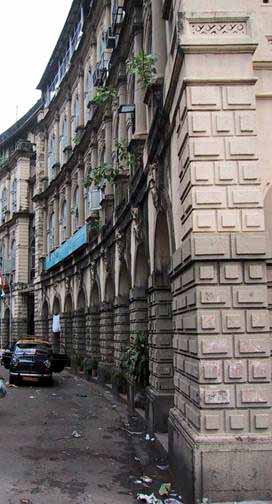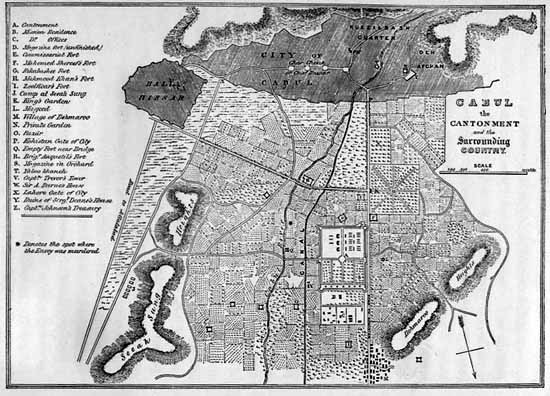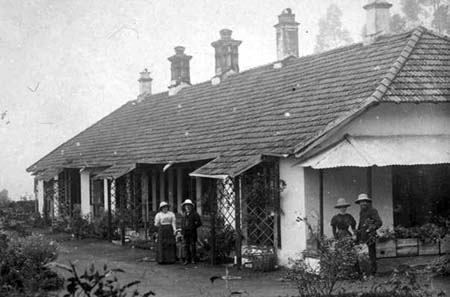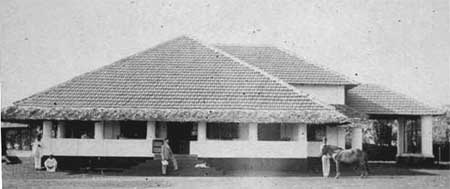Urban Design
While British supremacy did not change the fact that India was becoming rapidly urbanized, it did lead to new alignments and priorities, since the controlling power was now different. A number of new towns and new suburbs were built to house the British, and the pattern of new town planning changed. India was still divided into administrative districts as under the Mughals, and the towns which functioned as district headquarters were the ones where most of the new architecture was built.
The planning and urban design policies of the British followed certain principles – (a) their perceptions of the nature of the Indian city, (b) the fear of further revolts along the lines of the Mutiny of 1857, (c) Haussmann’s plan for Paris which had become so popular in Europe and which advocated cutting through and demolishing old city centers to make space for new construction and boulevards, and (d) planning techniques already in use for Britain’s industrial cities.
In the main the effort was to physically and socially separate the Europeans from the indigenous populace – the so-called ‘White’ and ‘Black’ towns of Madras being an example. This being done an effort, though sometimes belated, was also made to enforce sanitary and developmental guidelines on the old towns, though these had little effect as in the main they failed to take into account traditional ways of community life. In some cases new urban design smacked of retribution – Delhi and Lucknow in particular, being the centers of the Mutiny of 1857, lost large parts of their historic areas to new British planning and city-core demolitions.
 The economic boom of the later half of the 19th century translated into frenetic building activity in British India. The application of urban design guidelines resulted in the unified character that old British settlements in India still possess. These urban design projects could not fail to be influenced by precedents in Britain: the Royal Crescent at Bath by John Wood, and the Quadrant in Regent’s Park, London by John Nash were particularly influential, translating into Elphinstone Circle (now Horniman Circle) in Bombay. As pressure on space grew, British architecture progressed from single buildings set in open surrounding to more densely packed urban schemes, as in the cities of Calcutta and Bombay.
The economic boom of the later half of the 19th century translated into frenetic building activity in British India. The application of urban design guidelines resulted in the unified character that old British settlements in India still possess. These urban design projects could not fail to be influenced by precedents in Britain: the Royal Crescent at Bath by John Wood, and the Quadrant in Regent’s Park, London by John Nash were particularly influential, translating into Elphinstone Circle (now Horniman Circle) in Bombay. As pressure on space grew, British architecture progressed from single buildings set in open surrounding to more densely packed urban schemes, as in the cities of Calcutta and Bombay.
In addition to major urban design schemes, it was the civil lines and the cantonments which remain today a major evidence of 19th century British presence, and which in turn have influenced much middle-class housing development in modern India. This stems from their perception as the colonies of the elite. The cantonments and civil lines both were generally laid out as gridiron planned communities with central thoroughfares (the famous ‘Mall Roads’), with tree-lined streets, regularly divided building plots and bungalows as the main housing type. Churches and cemeteries, clubs, race and golf courses, and other trappings of an easy civil life were soon to follow.
The Cantonment and the Bungalow

Kabul Cantonment
The Cantonment was a British military settlement which was to spread out all over India wherever the British were present in sizable numbers. Originally conceived as a military base for British troops, the cantonment also began to house civilians who were associated with servicing the military, and developed into a full-fledged mini-city of its own. The second half of the 19th century saw this transformation complete. Bangalore cantonment had, for example, a population of 100,000 by the early 20th century and consisted of public offices, churches, parks, shops and schools. It was an entity distinct from the old city – traffic between the two had to stop at a toll-gate and pay entry tax. The cantonment thus developed into a European town in India, whose main house type was the bungalow.
The bungalow’s design evolved as a type over a hundred years. While the actual model for a bungalow remains controversial, it appears to have dual origins: the detached rural Bengal house sitting in its compound (from the word root bangla – from Bengal), and the British suburban villa. It was a fusion of these two types that led to a building form which would later become an enduring symbol of the Raj.
 The first bungalows inhabited by the East India Company agents were initially the same as the kutcha local ones, but gradually outstripped their origins to become an accurate reflection of hierarchy amongst the English community. The typical residential bungalow for the wealthy, for example, was set back from the road by a walled compound. The amount of land enclosed was a symbol of status. For a senior officer a ratio of 15:1, garden to built form, was appropriate, while for a beginning rank it could even be 1:1. In this sense the British showed a hierarchical system no less developed than the complex caste system which they ascribed to India.
The first bungalows inhabited by the East India Company agents were initially the same as the kutcha local ones, but gradually outstripped their origins to become an accurate reflection of hierarchy amongst the English community. The typical residential bungalow for the wealthy, for example, was set back from the road by a walled compound. The amount of land enclosed was a symbol of status. For a senior officer a ratio of 15:1, garden to built form, was appropriate, while for a beginning rank it could even be 1:1. In this sense the British showed a hierarchical system no less developed than the complex caste system which they ascribed to India.
 The early bungalows had long, low classical lines and detailing. The Gothic revival in England brought about a corresponding change in bungalow design – spawning buildings with pitched roofs and richly carpentered details including such features as the ‘monkey tops’ of Bangalore. The Classical bungalow with its Doric, and later, in New Delhi for instance, Tuscan orders became a symbol not only of an European heritage but also of the military and political might of Britain. That the bungalow continues to evoke associations of wealth and power is evident from its continued relevance as a building type in India today.
The early bungalows had long, low classical lines and detailing. The Gothic revival in England brought about a corresponding change in bungalow design – spawning buildings with pitched roofs and richly carpentered details including such features as the ‘monkey tops’ of Bangalore. The Classical bungalow with its Doric, and later, in New Delhi for instance, Tuscan orders became a symbol not only of an European heritage but also of the military and political might of Britain. That the bungalow continues to evoke associations of wealth and power is evident from its continued relevance as a building type in India today.  The economic boom of the later half of the 19th century translated into frenetic building activity in British India. The application of urban design guidelines resulted in the unified character that old British settlements in India still possess. These urban design projects could not fail to be influenced by precedents in Britain: the Royal Crescent at Bath by John Wood, and the Quadrant in Regent’s Park, London by John Nash were particularly influential, translating into Elphinstone Circle (now Horniman Circle) in Bombay. As pressure on space grew, British architecture progressed from single buildings set in open surrounding to more densely packed urban schemes, as in the cities of Calcutta and Bombay.
The economic boom of the later half of the 19th century translated into frenetic building activity in British India. The application of urban design guidelines resulted in the unified character that old British settlements in India still possess. These urban design projects could not fail to be influenced by precedents in Britain: the Royal Crescent at Bath by John Wood, and the Quadrant in Regent’s Park, London by John Nash were particularly influential, translating into Elphinstone Circle (now Horniman Circle) in Bombay. As pressure on space grew, British architecture progressed from single buildings set in open surrounding to more densely packed urban schemes, as in the cities of Calcutta and Bombay.
 The first bungalows inhabited by the East India Company agents were initially the same as the kutcha local ones, but gradually outstripped their origins to become an accurate reflection of hierarchy amongst the English community. The typical residential bungalow for the wealthy, for example, was set back from the road by a walled compound. The amount of land enclosed was a symbol of status. For a senior officer a ratio of 15:1, garden to built form, was appropriate, while for a beginning rank it could even be 1:1. In this sense the British showed a hierarchical system no less developed than the complex caste system which they ascribed to India.
The first bungalows inhabited by the East India Company agents were initially the same as the kutcha local ones, but gradually outstripped their origins to become an accurate reflection of hierarchy amongst the English community. The typical residential bungalow for the wealthy, for example, was set back from the road by a walled compound. The amount of land enclosed was a symbol of status. For a senior officer a ratio of 15:1, garden to built form, was appropriate, while for a beginning rank it could even be 1:1. In this sense the British showed a hierarchical system no less developed than the complex caste system which they ascribed to India.  The early bungalows had long, low classical lines and detailing. The Gothic revival in England brought about a corresponding change in bungalow design – spawning buildings with pitched roofs and richly carpentered details including such features as the ‘monkey tops’ of Bangalore. The Classical bungalow with its Doric, and later, in New Delhi for instance, Tuscan orders became a symbol not only of an European heritage but also of the military and political might of Britain. That the bungalow continues to evoke associations of wealth and power is evident from its continued relevance as a building type in India today.
The early bungalows had long, low classical lines and detailing. The Gothic revival in England brought about a corresponding change in bungalow design – spawning buildings with pitched roofs and richly carpentered details including such features as the ‘monkey tops’ of Bangalore. The Classical bungalow with its Doric, and later, in New Delhi for instance, Tuscan orders became a symbol not only of an European heritage but also of the military and political might of Britain. That the bungalow continues to evoke associations of wealth and power is evident from its continued relevance as a building type in India today. 



























